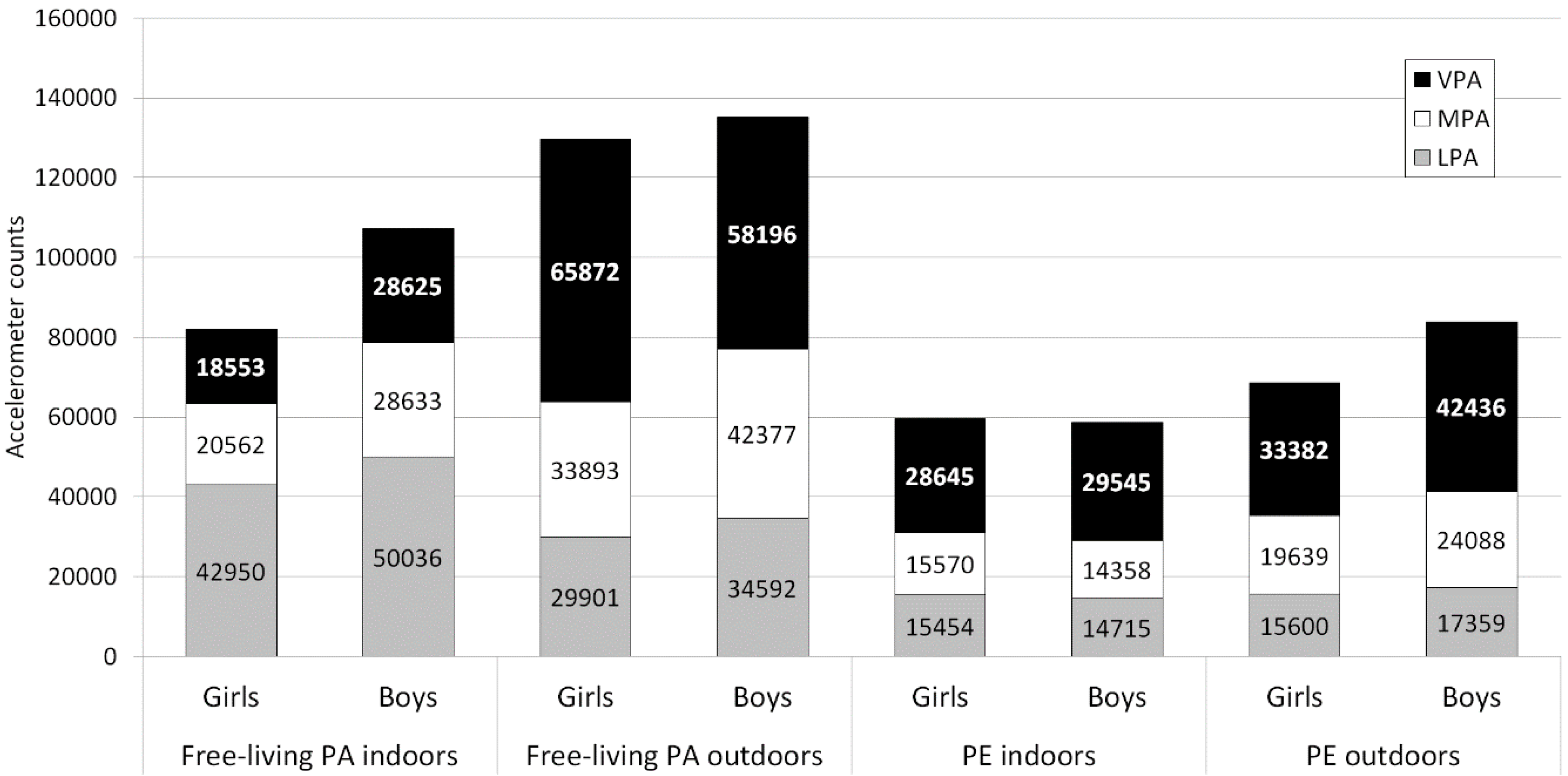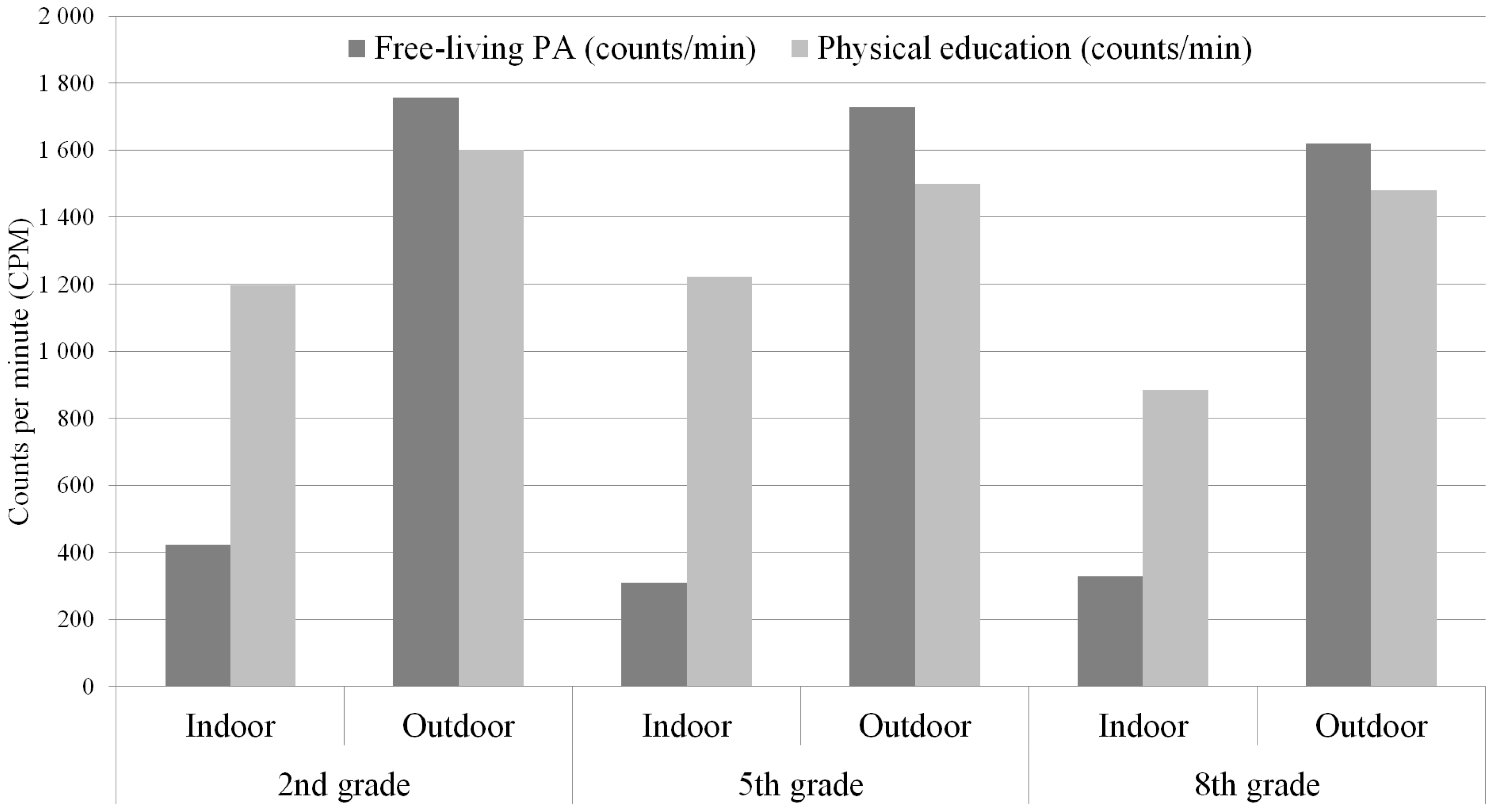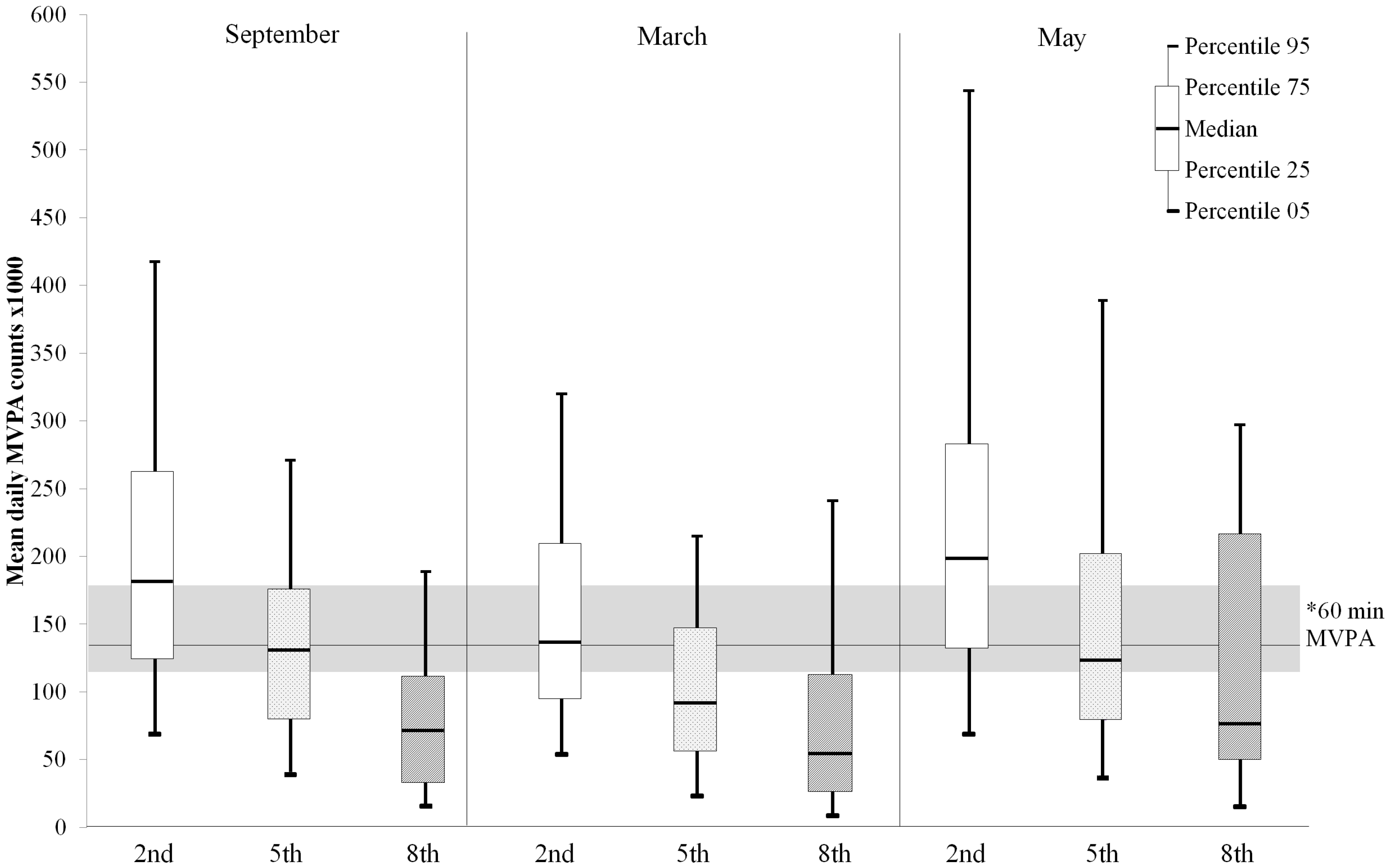Compulsory School In- and Outdoors—Implications for School Children’s Physical Activity and Health during One Academic Year
Abstract
:1. Introduction
2. Methods
2.1. Research Design and Participants
2.2. Procedures
2.3. Physical Activity Assessments
2.4. Statistical Analysis
3. Results
3.1. Time Indoors vs. Outdoors
3.2. Predictors for Physical Activity during School Stay
3.3. Physical Activity Outdoors vs. Indoors
3.4. Physical Activity, Weather, and Season
4. Discussion
Implications for School Health
5. Conclusions
Acknowledgments
Author Contributions
Conflicts of Interest
Abbreviations
| CPM | Counts per minute |
| PA | Physical activity |
| LPA | Light physical activity |
| MVPA | Moderate to vigorous physical activity |
| PE | Physical education |
| SED | Sedentariness |
References
- Dessing, D.; Pierik, F.H.; Sterkenburg, R.P.; van Dommelen, P.; Maas, J.; de Vries, S.I. Schoolyard physical activity of 6–11 year old children assessed by GPS and accelerometry. Int. J. Behav. Nutr. Phys. Act. 2013, 10, 97. [Google Scholar] [CrossRef] [PubMed]
- Griew, P.; Page, A.; Thomas, S.; Hillsdon, M.; Cooper, A.R. The school effect on children’s school time physical activity: The peach project. Prev. Med. 2010, 51, 282–286. [Google Scholar] [CrossRef] [PubMed]
- Tudor-Locke, C.; Lee, S.M.; Morgan, C.F.; Beighle, A.; Pangrazi, R.P. Children’s pedometer-determined physical activity during the segmented school day. Med. Sci. Sports Exerc. 2006, 38, 1732–1738. [Google Scholar] [CrossRef] [PubMed]
- McCurdy, L.E.; Winterbottom, K.E.; Mehta, S.S.; Roberts, J.R. Using nature and outdoor activity to improve children’s health. Curr. Probl. Pediatr. Adolesc. Health Care 2010, 40, 102–117. [Google Scholar] [CrossRef] [PubMed]
- Efrat, M. The relationship between low-income and minority children’s physical activity and academic-related outcomes: A review of the literature. Health Educ. Behav. 2011, 38, 441–451. [Google Scholar] [CrossRef] [PubMed]
- Ericsson, I.; Karlsson, M.K. Motor skills and school performance in children with daily physical education in school—A 9-year intervention study. Scand. J. Med. Sci. Sports 2014, 24, 273–278. [Google Scholar] [CrossRef] [PubMed]
- Burrows, M. Exercise and bone mineral accrual in children and adolescents. J. Sports Sci. Med. 2007, 6, 305–312. [Google Scholar] [PubMed]
- Fam, B.; Amouzegar, A.; Arzhan, S.; Ghanbariyan, A.; Delshad, M.; Hosseinpanah, F.; Azizi, F. Association between physical activity and metabolic risk factors in adolescents: Tehran lipid and glucose study. Int. J. Prev. Med. 2013, 4, 1011–1017. [Google Scholar] [PubMed]
- Janssen, I.; Leblanc, A.G. Systematic review of the health benefits of physical activity and fitness in school-aged children and youth. Int. J. Behav. Nutr. Phys. Act. 2010, 7, 40. [Google Scholar] [CrossRef] [PubMed]
- Mithal, A.; Wahl, D.A.; Bonjour, J.P.; Burckhardt, P.; Dawson-Hughes, B.; Eisman, J.A.; El-Hajj Fuleihan, G.; Josse, R.G.; Lips, P.; Morales-Torres, J.; et al. Global vitamin D status and determinants of hypovitaminosis D. Osteoporos Int. 2009, 20, 1807–1820. [Google Scholar] [CrossRef] [PubMed]
- Pan, C.W.; Ramamurthy, D.; Saw, S.M. Worldwide prevalence and risk factors for myopia. Ophthalmic Physiol. Opt. 2012, 32, 3–16. [Google Scholar] [CrossRef] [PubMed]
- Blair, S.N.; LaMonte, M.J. How much and what type of physical activity is enough? What physicians should tell their patients. Arch. Intern. Med. 2005, 165, 2324–2325. [Google Scholar] [CrossRef] [PubMed]
- Strong, W.B.; Malina, R.M.; Blimkie, C.J.; Daniels, S.R.; Dishman, R.K.; Gutin, B.; Hergenroeder, A.C.; Must, A.; Nixon, P.A.; Pivarnik, J.M.; et al. Evidence based physical activity for school-age youth. J. Pediatr. 2005, 146, 732–737. [Google Scholar] [CrossRef] [PubMed]
- Guinhouya, B.C.; Samouda, H.; de Beaufort, C. Level of physical activity among children and adolescents in Europe: A review of physical activity assessed objectively by accelerometry. Public Health 2013, 127, 301–311. [Google Scholar] [CrossRef] [PubMed]
- Trost, S.G.; Pate, R.R.; Sallis, J.F.; Freedson, P.S.; Taylor, W.C.; Dowda, M.; Sirard, J. Age and gender differences in objectively measured physical activity in youth. Med. Sci. Sports Exerc. 2002, 34, 350–355. [Google Scholar] [CrossRef] [PubMed]
- Pagels, P.; Raustorp, A.; de Leon, A.P.; Martensson, F.; Kylin, M.; Boldemann, C. A repeated measurement study investigating the impact of school outdoor environment upon physical activity across ages and seasons in swedish second, fifth and eighth graders. BMC Public Health 2014, 14, 803. [Google Scholar] [CrossRef] [PubMed]
- Metcalf, B.S.; Hosking, J.; Jeffery, A.N.; Henley, W.E.; Wilkin, T.J. Exploring the adolescent fall in physical activity: A 10-year cohort study (Earlybird 41). Med. Sci. Sports Exerc. 2015, 47, 2084–2092. [Google Scholar] [CrossRef] [PubMed]
- Raustorp, A.; Ekroth, Y. Tracking of pedometer-determined physical activity: A 10-year follow-up study from adolescence to adulthood in Sweden. J. Phys. Act. Health 2013, 10, 1186–1192. [Google Scholar] [PubMed]
- Tucker, P.; Gilliland, J. The effect of season and weather on physical activity: A systematic review. Public Health 2007, 121, 909–922. [Google Scholar] [CrossRef] [PubMed]
- Rowlands, A.V.; Hughes, D.R. Variability of physical activity patterns by type of day and season in 8–10-year-old boys. Res. Q. Exerc. Sport 2006, 77, 391–395. [Google Scholar] [PubMed]
- Rowlands, A.V.; Pilgrim, E.L.; Eston, R.G. Seasonal changes in children’s physical activity: An examination of group changes, intra-individual variability and consistency in activity pattern across season. Ann. Hum. Biol. 2009, 36, 363–378. [Google Scholar] [CrossRef] [PubMed]
- Beighle, A.; Morgan, C.F.; Le Masurier, G.; Pangrazi, R.P. Children’s physical activity during recess and outside of school. J. Sch. Health 2006, 76, 516–520. [Google Scholar] [CrossRef] [PubMed]
- Ridgers, N.D.; Stratton, G.; Fairclough, S.J.; Twisk, J.W. Children’s physical activity levels during school recess: A quasi-experimental intervention study. Int. J. Behav. Nutr. Phys. Act. 2007, 4, 19. [Google Scholar] [CrossRef] [PubMed]
- World Health Organization. Global Action Plan for the Prevention and Control of NCDS 2013–2020. Available online: http://www.who.int/nmh/events/ncd_action_plan/en/ (accessed on 1 February 2014).
- Tran, I.; Clark, B.R.; Racette, S.B. Physical activity during recess outdoors and indoors among urban public school students, St. Louis, Missouri, 2010–2011. Prev. Chronic Dis. 2013, 10, E196. [Google Scholar] [CrossRef] [PubMed]
- Coombes, E.; van Sluijs, E.; Jones, A. Is environmental setting associated with the intensity and duration of children’s physical activity? Findings from the speedy GPS study. Health Place 2013, 20, 62–65. [Google Scholar] [CrossRef] [PubMed]
- Tandon, P.S.; Saelens, B.E.; Zhou, C.; Kerr, J.; Christakis, D.A. Indoor vs. outdoor time in preschoolers at child care. Am. J. Prev. Med. 2013, 44, 85–88. [Google Scholar] [CrossRef] [PubMed]
- Flynn, J.I.; Coe, D.P.; Larsen, C.A.; Rider, B.C.; Conger, S.A.; Bassett, D.R., Jr. Detecting indoor and outdoor environments using the Actigraph GT3X+ light sensor in children. Med. Sci. Sports Exerc. 2014, 46, 201–206. [Google Scholar] [CrossRef] [PubMed]
- McClain, J.J.; Abraham, T.L.; Brusseau, T.A., Jr.; Tudor-Locke, C. Epoch length and accelerometer outputs in children: Comparison to direct observation. Med. Sci. Sports Exerc. 2008, 40, 2080–2087. [Google Scholar] [CrossRef] [PubMed]
- Baquet, G.; Stratton, G.; van Praagh, E.; Berthoin, S. Improving physical activity assessment in prepubertal children with high-frequency accelerometry monitoring: A methodological issue. Prev. Med. 2007, 44, 143–147. [Google Scholar] [CrossRef] [PubMed]
- Evenson, K.R.; Catellier, D.J.; Gill, K.; Ondrak, K.S.; McMurray, R.G. Calibration of two objective measures of physical activity for children. J. Sports Sci. 2008, 26, 1557–1565. [Google Scholar] [CrossRef] [PubMed]
- Trost, S.G.; Loprinzi, P.D.; Moore, R.; Pfeiffer, K.A. Comparison of accelerometer cut points for predicting activity intensity in youth. Med. Sci. Sports Exerc. 2011, 43, 1360–1368. [Google Scholar] [CrossRef] [PubMed]
- Sallis, J.F.; Prochaska, J.J.; Taylor, W.C. A review of correlates of physical activity of children and adolescents. Med. Sci. Sports Exerc. 2000, 32, 963–975. [Google Scholar] [CrossRef] [PubMed]
- Ferreira, I.; van der Horst, K.; Wendel-Vos, W.; Kremers, S.; van Lenthe, F.J.; Brug, J. Environmental correlates of physical activity in youth—A review and update. Obes. Rev. 2007, 8, 129–154. [Google Scholar] [CrossRef] [PubMed]
- Silva, P.; Santos, R.; Welk, G.; Mota, J. Seasonal differences in physical activity and sedentary patterns: The relevance of the PA context. J. Sports Sci. Med. 2011, 10, 66–72. [Google Scholar] [PubMed]
- Kolle, E.; Steene-Johannessen, J.; Andersen, L.B.; Anderssen, S.A. Seasonal variation in objectively assessed physical activity among children and adolescents in Norway: A cross-sectional study. Int. J. Behav. Nutr. Phys. Act. 2009, 6, 36. [Google Scholar] [CrossRef] [PubMed] [Green Version]
- Cooper, A.R.; Page, A.S.; Wheeler, B.W.; Hillsdon, M.; Griew, P.; Jago, R. Patterns of GPS measured time outdoors after school and objective physical activity in English children: The PEACH project. Int. J. Behav. Nutr. Phys. Act. 2010, 7, 31. [Google Scholar] [CrossRef] [PubMed] [Green Version]
- Pagels, P.; Wester, U.; Soderstrom, M.; Lindelof, B.; Boldemann, C. Suberythemal sun exposures at Swedish schools depend on sky views of the outdoor environments—Possible implications for pupils’ health. Photochem. Photobiol. 2016, 92, 201–207. [Google Scholar] [CrossRef] [PubMed]
- Sallis, J.F.; Saelens, B.E. Assessment of physical activity by self-report: Status, limitations, and future directions. Res. Q. Exerc. Sport 2000, 71, 1–14. [Google Scholar] [CrossRef] [PubMed]



| Grade | Age in March (years) | BMI in March (kg/m2) | Outdoor Time in September (min) | Outdoor Time in March (min) | Outdoor Time in May (min) | |
|---|---|---|---|---|---|---|
| Mean (SD) | Mean (SD) | Mean (SD) | Mean (SD) | Mean (SD) | ||
| 2nd grade | Boys (n = 33), Girls (n = 31) | 8.7 (0.5) | 17.3 (1.8) | 113.9 (64.1) | 85.8.0 (43.6) | 128.8 (53.7) |
| 5th grade | Boys (n = 43), Girls (n = 46) | 11.7 (0.3) | 19.5 (3.3) | 77.5 (41.5) | 57.6 (52.1) | 77.0 (45.1) |
| 8th grade | Boys (n = 16), Girls (n = 10) | 14.7 (0.3) | 21.7 (2.6) | 42.3 (36.7) | 17.7 (14.5) | 60.0 (37.3) |
| The GENMOD Procedure, Repeated for Season and Measure Day, Estimate (Standard Error, SE) | Dependent Variable: Total Daily Accelerometer Counts | ||||
|---|---|---|---|---|---|
| Variable | (I) | (J) | Estimate ** (Diff. I-J) | SE | p-Value |
| Season | March (ref.) | May | −44,857 | 20,823.0 | 0.0312 |
| Measured day * | Day1 (ref.) | Day 2 | 14,765 | 7146.4 | 0.0388 |
| Day 3 | 39,306 | 10,137.0 | 0.0001 | ||
| Day 4 | 46,678 | 8027.0 | <0.0001 | ||
| Day 5 | 39,723 | 8820.0 | <0.0001 | ||
| Day 2 (ref.) | Day 3 | 24,541 | 9730.6 | 0.0117 | |
| Day 4 | 31,914 | 8117.8 | <0.0001 | ||
| Day 5 | 24,958 | 8647.0 | 0.0039 | ||
| Grade | 2nd grade (ref.) | 5th grade | 67,497 | 10,839.0 | <0.0001 |
| 8th grade | 86,440 | 15,032.0 | <0.0001 | ||
| Gender | Girl (ref.) | Boy | −32,194 | 9254.0 | 0.0005 |
| Weather | Cloudless (ref.) | grey cloudiness | 28,328 | 8511.6 | 0.0009 |
| partly cloudy | 13,213 | 5760.0 | 0.0218 | ||
| Grey cloudiness (ref.) | partly cloudy | −15,115 | 7432.0 | 0.0420 | |
| white cloudiness | −21,460 | 8730.4 | 0.0140 | ||
| Time outdoors (min) | 1076.7 | 71.8 | <0.0001 | ||
| Physical Activity | CPM | MVPA Counts | ||||
|---|---|---|---|---|---|---|
| Mean | SD | p-Value | Mean | SD | p-Value | |
| Free-living PA outdoors | 1715.6 | 522.3 | <0.0001 | 91,395.6 | 59,665.6 | <0.0001 |
| Free-living PA indoors | 358.4 | 139.4 | 48,766.1 | 29,701.7 | ||
| Free-living PA outdoors, girls | 1698.9 | 541.9 | <0.0001 | 94,443.6 | 69,621.3 | <0.0001 |
| Free-living PA indoors, girls | 313.1 | 97.4 | 39,555.9 | 20,853.4 | ||
| Free-living PA outdoors, boys | 1731.3 | 505.5 | 0.0002 | 88,513.2 | 48,635.4 | <0.0001 |
| Free-living PA indoors, boys | 401.3 | 158.8 | 57,475.7 | 34,012.4 | ||
| PE outdoors | 1494.4 | 608.4 | <0.0001 | 56,496.9 | 30,555.1 | <0.0001 |
| PE indoors | 1204.1 | 749.7 | 41,313.7 | 32,561.3 | ||
| PE outdoors, girls | 1333.6 | 547.0 | 0.0690 | 48,637.6 | 27,136.0 | 0.0909 |
| PE indoors, girls | 1133.8 | 630.6 | 38,989.7 | 29,065.7 | ||
| PE outdoors, boys | 1649.3 | 627.2 | <0.0001 | 64,072.1 | 31,885.7 | <0.0001 |
| PE indoors, boys | 1265.0 | 839.3 | 43,325.6 | 35,404.8 | ||
© 2016 by the authors; licensee MDPI, Basel, Switzerland. This article is an open access article distributed under the terms and conditions of the Creative Commons Attribution (CC-BY) license (http://creativecommons.org/licenses/by/4.0/).
Share and Cite
Pagels, P.; Raustorp, A.; Guban, P.; Fröberg, A.; Boldemann, C. Compulsory School In- and Outdoors—Implications for School Children’s Physical Activity and Health during One Academic Year. Int. J. Environ. Res. Public Health 2016, 13, 699. https://doi.org/10.3390/ijerph13070699
Pagels P, Raustorp A, Guban P, Fröberg A, Boldemann C. Compulsory School In- and Outdoors—Implications for School Children’s Physical Activity and Health during One Academic Year. International Journal of Environmental Research and Public Health. 2016; 13(7):699. https://doi.org/10.3390/ijerph13070699
Chicago/Turabian StylePagels, Peter, Anders Raustorp, Peter Guban, Andreas Fröberg, and Cecilia Boldemann. 2016. "Compulsory School In- and Outdoors—Implications for School Children’s Physical Activity and Health during One Academic Year" International Journal of Environmental Research and Public Health 13, no. 7: 699. https://doi.org/10.3390/ijerph13070699
APA StylePagels, P., Raustorp, A., Guban, P., Fröberg, A., & Boldemann, C. (2016). Compulsory School In- and Outdoors—Implications for School Children’s Physical Activity and Health during One Academic Year. International Journal of Environmental Research and Public Health, 13(7), 699. https://doi.org/10.3390/ijerph13070699






